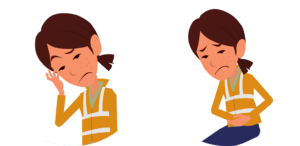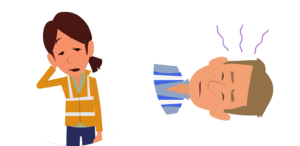Are You Prepared to Work in the Heat?
British Columbia often faces hot and humid weather from spring to fall. Temperatures can be extreme. It’s critical for you to understand how heat can affect your work as a crane operator in demanding environments.
The cabs of tower cranes, mobile cranes and boom trucks can quickly heat up, putting operators at risk of heat-related illness.
It is important for you to know that heat stress can be very serious, even deadly. Learn to recognize, treat, prevent and monitor heat stress on the job.
Employers, supervisors, and workers should work together to protect the well-being of crane operators and others working in high temperatures. You can use these resources to help educate yourself and your co-workers on how to prevent and manage heat stress.
What is Heat Stress?
Heat stress happens when the body heats up faster than it can cool itself, especially in hot, humid conditions when sweating isn’t enough.
Heat stress causes the body’s core temperature to rise. Our bodies naturally cool down by sweating, but in some hot, humid conditions, sweating isn’t enough. If the body can’t cope, it could start to shut down.
Are You at Risk of Heat Stress?
You should know when you or another worker could be at risk for heat stress.
Everyone on the worksite has a role to play in protecting themselves and each other from the risks associated with heat stress.
Heat stress can occur when you or others perform physical labour in hot, humid environments and when working in closed areas without adequate ventilation. It can happen indoors or outdoors.
Factors that can cause heat stress include:
- working in direct sunlight in the summer months
- humidity in the workplace (more than 50% relative humidity)
- working inside crane cabs (without ventilation)
The effects of hot weather can be compounded by external heat sources and nearby activities.
One of the most simple and effective ways to avoid heat stress is to stay hydrated.
Drink lots of water regularly.
You can estimate how much water you need using a Heat Stress Calculator.
Examples include working inside a crane cab where the heat can be magnified by the windows, being near road work like laying asphalt, or doing rigging work outside in the sun.
Protective clothing can also contribute to heat stress if it is heavy or doesn’t allow the skin to breathe.
You can use this handy humidex-based Heat Stress Calculator to help assess your working conditions and provide some general heat prevention guidelines.
Recognizing Heat Stress
Signs of heat-related illnesses can range from discomfort and pain, like heat rash and heat cramps, to life-threatening conditions such as heat exhaustion and heat stroke.
Whenever possible, a good practice is to partner with other nearby workers to monitor each other or check in with one another for signs of heat stress.
Explore the signs of heat stress ranging from mild, moderate, to severe in the slides below. Be familiar with the symptoms of heat stress so that you know what to look for.
Mild Heat Stress
Heat Rash & Heat Cramps

Typical Symptoms
Red blotches and extreme itchiness on areas damp with sweat.
Prickling or stinging sensation on the skin where you are sweating.
Muscle pain or spasms in the legs, arms or abdomen.
Cool, moist skin.
What to Do
Drink water.
Rest in a cool environment.
Take a cool shower or spray yourself with water.Dry your clothes and skin thoroughly.
Moderate to Severe Heat Stress
Heat Exhaustion
If not treated promptly, heat exhaustion can lead to heat stroke.
It takes at least 30 minutes to cool your body after suffering heat exhaustion.

Typical Symptoms
Weakness
Headache
Abnormal breathing (rapid or shallow)
Nausea or vomiting
Feeling faint
What to Do
Rest in a cool environment for at least half an hour.
Drink cool water.
Take off unnecessary clothing.
Take a cool shower or spray yourself with water.
Severe Heat Stress
Heat Stroke
Heat stroke occurs when the body can no longer cool itself and its temperature rises to critical levels. It can be fatal. Immediate medical attention is required.

Typical Symptoms
Irrational behaviour
Confusion
Loss of consciousness
Convulsions
Hot, dry skin (not sweating despite the heat)
What to Do
Call for medical help right away.
While waiting, immerse the worker’s whole body in a tub of cool water or spray the worker with cool water from a hose. If possible, wrap the worker’s body with sheets soaked in cool water. Get the worker to hospital immediately.
Heat may affect people in different ways and its affects are influenced by many factors. It’s important to pay attention to the signs of heat stress and respond to the individual and the situation.
If you have a medical condition or are taking medication that can increase your sensitivity to the heat, get advice from your doctor about how to best protect yourself from heat stress.
Not everyone reacts to heat in the same way. It’s important to pay attention to the signs of heat stress.
What to Do About Heat Stress
One of the most simple and effective ways to avoid heat stress is to stay hydrated. Drink lots of water regularly.
If you start feeling symptoms, take breaks in a cool, breezy spot and drink cool fluids. If you continue feeling unwell or if your skin feels very hot and dry and you have stopped sweating, seek medical help right away.
Believe it or not the color of your pee (urine) is a good indicator of your current level of hydration. You can download our urine chart for reference.
- Check the colour of your stream. Don’t look at the colour of your urine in the bowl as it may appear lighter when diluted
- No amount of acclimatization can reduce your body’s requirement for water
- Drink water every 15 to 20 minutes, even if you aren’t thirsty. By the time you’re thirsty, you’re already dehydrated.
More Ways to Prevent Heat Stress
If you know it’s going to be hot at work, be prepared:
- Wear light clothing that still provides adequate protection from the sun and from workplace hazards.
- Cover your head and neck to prevent exposure to direct sunlight.
- Wear reflective clothing in situations where there is a lot of radiant heat.
- Consider air, water or ice-cooled insulated clothing for very hot environments.
- Have cool drinking water close to where you are working.
- Avoid clothing that doesn’t breathe well when possible, such as chemical protective clothing. If you must wear this kind of protective clothing, pay close attention to symptoms of heat stress.
- Take frequent rest breaks to cool off.
- See if you can work in cooler shaded areas during the hottest times of the day.
- Talk to your supervisor or employer if you feel unwell because of the heat.
BC Occupational Health and Safety Regulation (OHSR) Sections 7.26-7.32
sets out the requirements for on-site testing for measuring, managing and controlling exposure to heat.
Your Heat Stress Responsibilities
Whether you’re an employer, a supervisor, a crane operator or other worker, you have obligations.
Some of these are written into law, like the Occupational Health and Safety Regulation (OHSR), and some are simply matters of looking out for each other as co-workers.
Before starting work in hot environments, consider these prevention points in a heat stress toolbox meeting
Watch out for each other. If you see someone with signs of heat stress, speak up.
- Sometimes, people who may be affected by heat stress don’t recognize the symptoms.
- If you recognize someone who is sweating more than usual, looks flushed with redness or is hyperventilating, the person might be suffering from heat stress.
- If you recognize someone who has developed rashes, muscle cramping, headaches or dizziness—or feels faint or faints, these could be signs of heat stress.
- Use the BC Crane Safety Toolbox Talk: Working in Hot Conditions to help build your toolbox talk.
Pre-Job Start Checklist
- The American Industrial Hygiene Association (AIHA) provides a checklist of things to consider before starting work in hot environments.
- Are adequate supplies of cool drinks available?
- What is the major source of heat stress and how can it be mitigated (e.g. protective clothing requires particular strategies)?
- If radiant shielding (including shade) is possible, is it in the most strategic location?
- Is temperature monitoring equipment available at the work site?
- Are work guidelines that are appropriate to the situation available to workers and supervisors?
- Are first aid supplies available that are appropriate to heat/cold emergencies?
- Has an appropriate work rate been determined, and is there sufficient manpower to stay on schedule despite a slower work pace?
- Have supervisors been instructed to remove workers at the first sign of problems?
- Have workers been properly and thoroughly acclimatized (or reacclimatized after a time away, like vacation or return to work, from the heat stressing environment)?
- Is a cool recovery/rest area available?
- Are workers and supervisors trained in recognizing the symptoms, and providing first aid treatment of heat injury?
- Is there a means of calling emergency medical support? Do workers know how and where to call emergency medical support?
- Is the clothing appropriate (minimal obstruction of sweat evaporation and maximal protection from radiant heat i.e. use the lightest, most permeable clothing that provides adequate safety)?
- Is the air velocity as high as practical?
- Have you considered installing air conditioning or continuous ventilation in the crane cab?
- Are workers well hydrated at the beginning of work?
- Is spot cooling available?
- Is microclimate cooling (e.g. cool type vests) available as needed?
- Have workers been reminded of appropriate safety precautions?
- Have workers who are pregnant, have relevant medical conditions or who are taking medication that increases their risk, have had previous heat injuries, and who have fever, been protected from elevated internal body temperatures?
Seek medical advice about a person’s fitness for work in hot environments before hot weather begins.
The way heat affects individual people varies and is influenced by many factors. It’s important to pay attention to the signs of heat stress and respond to the individual and the situation
Heat Stress Policies and Procedures
Your workplace policies and procedures, as well as scheduling and training, can help reduce the risk of heat stress. Here are some tips and ideas for making adjustments to the way work is organized.
- Assess the demands of all jobs and put a plan in place for hot days and workplaces.
- Consider the installation of air condition or increase ventilation in the crane cab
- Increase the frequency and length of rest breaks.
- Provide as many cool shady places to work and rest as possible.
- Schedule strenuous jobs for cooler times of the day such as in the early morning, late afternoon or night.
- Assign more workers or slow down the pace of work.
- Have cool drinking water available for workers.
- Remind workers to stay hydrated by drinking a cup of water at least every 15 to 20 minutes.
- Caution workers to avoid direct sunlight. Provide a shaded place to work and rest.
- Make sure workers have time to acclimatize to the heat.
- Train workers to recognize the signs and symptoms of heat stress.
- Start a “buddy system” so workers are encouraged to look out for each other or check in regularly with each other. People don’t always notice their own symptoms.
- Investigate heat-related incidents reported by workers.
- Make sure workers have access to first aid.
- Make sure your general emergency response plan includes how to respond to heat-related illnesses.
- Advise workers who are pregnant or have a medical condition to talk to their doctor about working in the heat and make appropriate adjustments.
Crane Employers & Heat Stress
Under the Occupational Health and Safety Regulation (OHSR), employers must take every reasonable precaution to protect workers. This includes protecting them from heat stress.
Do You Have a Heat Stress Control Plan?
Create a heat stress control plan or hot weather plan based on the work environment. Do this with the help of the joint health and safety committee or worker health and safety representative and have it in effect from May 1 to September 30 every year.
The plan should include:
- A statement of commitment from leadership/management and the joint health and safety committee.
- A statement of employer, supervisor and worker responsibilities.
- The criteria for “triggering” the plan. For example, start using the plan if:
- Humidex on-site reaches or exceeds 35. Environment Canada reports air temperature that exceeds 30°C and a humidex of 40
- Heat waves of 32°C or more are predicted for three or more days.
- The BC Ministry of Environment and Climate Change Strategy issues an Air Quality warning.
- Identifying hazards and risks. Some examples could include:
- Areas on the worksite with more exposure to high temperatures.
- Tasks that are physically demanding.
- Whether there is cool water and a cool place to rest available.
- Whether workers need to wear heavy protective equipment.
- Written procedures for eliminating or mitigating the identified hazards and risks.
- Training for workers, supervisors and employers. Topics could include:
- Definition of heat stress.
- Signs and symptoms of heat-related illness.
- Importance of reporting signs and symptoms to supervisors.
- When, how, and why to take breaks from hot work.
- Recognition, assessment, and evaluation of heat stress.
- Controls for heat stress.
- Emergency response and first aid.
For more information on creating a Heat Stress Control plan see WorkSafeBC’s guide Preventing Heat Stress at Work
Helping Workers Adjust to Hot Environments
An appropriately structured and implemented heat acclimatization program will enhance workers’ capacity to perform in hot conditions, consequently reducing the likelihood of heat-related illnesses and unsafe actions. Enhancing human heat-adaptive mechanisms can substantially boost the ability to withstand work in heat.
The more time a worker has to adjust to a hot environment, the better their body can handle the heat. It can take some time to adjust to heat, especially if there’s a sudden change in the weather like a heat wave or if workers are new to the conditions when they start a new job or come back after some time away.
Help workers with no experience in hot conditions or workers coming back to the job adjust by gradually increasing their activity level and time spent in the heat over a week or two. Typically, heat acclimatization can be achieved within 7 to 14 days of consistent exposure to the hot job environment, depending on workers’ ability to acclimatize.
It’s important to note that individuals exhibit varying levels of adaptability to heat, and they may need more time to adjust to hot environments. This diversity should be taken into consideration when addressing the needs of any group of workers. A worker’s general health condition and fitness level may impact how much time they need to adjust to hot environments. Pregnant people may also be more susceptible to heat.
For workers with no experience in hot conditions, there are two ways to help them tolerate the heat:
- gradually increase the activity level over one to two weeks
- gradually increase the amount of time spent in hot working conditions
e.g. For new workers, the schedule should be no more than 20% of the usual duration of work in the hot environment on day 1, increasing by no more than 20% each day. For workers with experience in hot conditions, but who may have been ill or away from work for 9 or more days, the worker will need to gradually readjust to the heat. For workers who have had previous experience with the job, the acclimatization regimen should be no more than 50% of the usual duration of work in the hot environment on day 1, 60% on day 2, 80% on day 3, and 100% on day 4.
You can find more information on heat acclimatization from The National Institute for Occupational Safety and Health: Heat Stress – Recommendations.
Engineering Controls to Heat Stress
A good place to start is with engineering controls such as:
- Exhausting heat and humidity in crane cabs with fans or air conditioning
- Ensuring crane operators can use fans in the cab if the temperature is below 35°C. If the temperature is above 35°C fans can just recirculate the hot air which doesn’t help.
- Providing cool, shaded work areas and air-conditioned rest areas.
Learn More About Heat Stress
Here is a collection of downloadable materials designed to help employers implement robust heat stress prevention programs from other authorities and organizations. From comprehensive checklists to posters and detailed guidelines, these resources cater to various learning styles and workplace settings. Whether you’re a safety manager looking to reinforce training protocols or an employee seeking practical tips, our collection ensures accessibility and relevance for all stakeholders involved in fostering a heat-safe work environment.
Explore these resources to establish preventive measures, cultivate awareness, and instill best practices. Our goal is to support workplaces in which individuals are equipped to recognize, address, and ultimately mitigate the risks associated with heat stress.
Related Links
CONTACT
BC CRANE SAFETY
PO Box 42066, RPO Guildford
Surrey, BC V3R 1S5
PHONE: 604-336-4699
FAX: 604-336-4510
EMAIL: info@bccranesafety.ca



